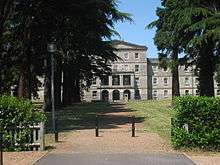John Whichcord Snr
John Whichcord Snr (1790–1860) was a British architect who worked in Maidstone, Kent and designed many public and institutional buildings in the town.
Life
Whichcord, the son of a surveyor, was born in Devizes, Wiltshire. He was articled to the Bath architect Charles Harcourt Masters and then worked in the drawing office of the architect of the London Docks, Daniel Asher Alexander, who was also engaged on the prison at Maidstone.[1] In 1819 Whichcord took over the post of surveyor of Maidstone gaol, and two years later also became surveyor of Canterbury gaol. In 1825, when the county surveyor of Kent was dismissed, Whichcord was appointed to the post.[2] His works in the county included the Maidstone Union Workhouse (1836), the Kent Fire Offices, the Maidstone Corn Exchange, and the West Kent Infirmary. He was also surveyor to the Medway Navigation Company, carrying out various works on the river, including tidal locks. The Kent County Lunatic Asylum is described as his Magnum Opus by John Newman (Buildings of England Series, 1969).

He designed the new churches of St John, Blindley Heath in Surrey, and Holy Trinity, Maidstone, St Stephen, Tovil, Holy Trinity, East Peckham, St Mary the Virgin, Platt, and Christ Church at Dunkirk, near Faversham, all in Kent. He also produced plans for enlargement or reseating of a number of existing ones.[3]
His son John Whichcord Jr. (1823–1885) was a notable architect.[4]
References
- The Gentlemans Magazine, Volume 209, 1860. p. 203
- Lansberry, HCF. Government and politics in Kent, 1640-1914, ISBN 0-85115-586-3, 2001,p.267
- Churchplansonline Archived 13 March 2012 at the Wayback Machine Retrieved 23 May 2011
-
